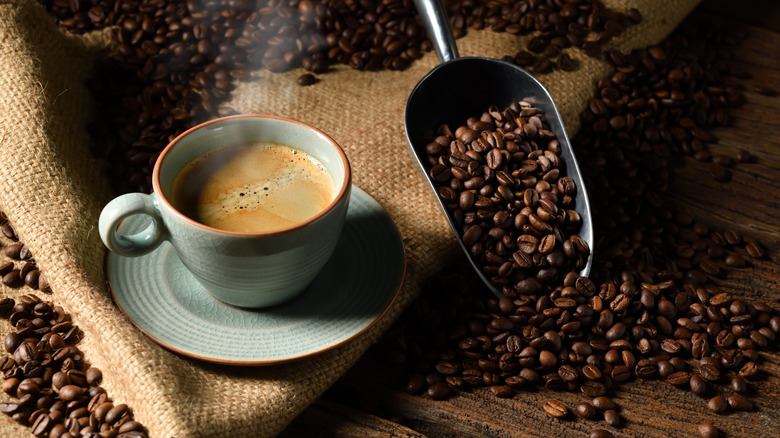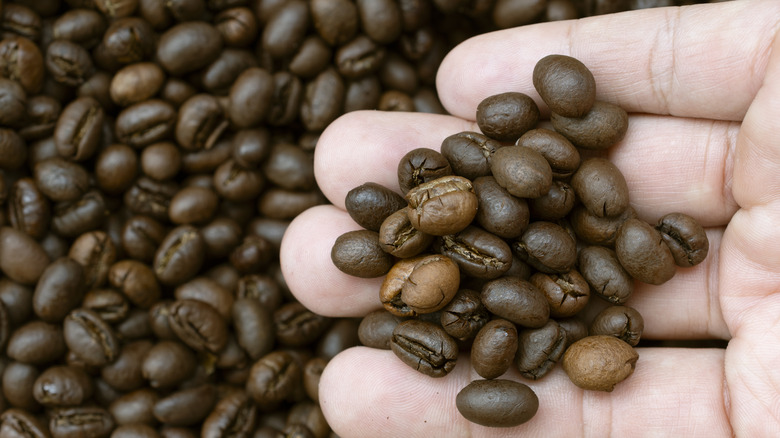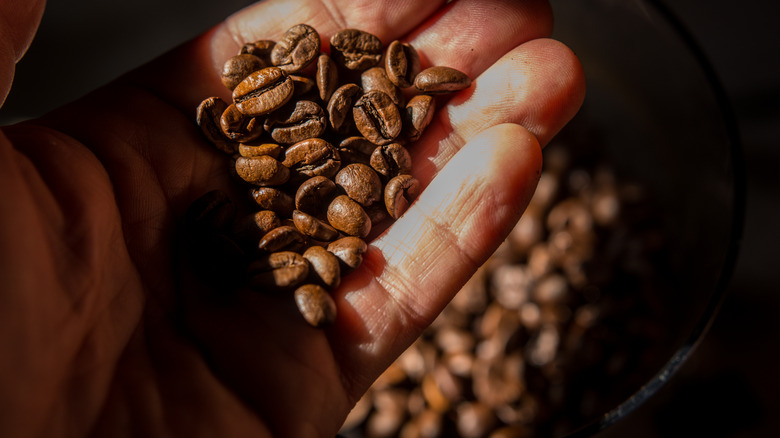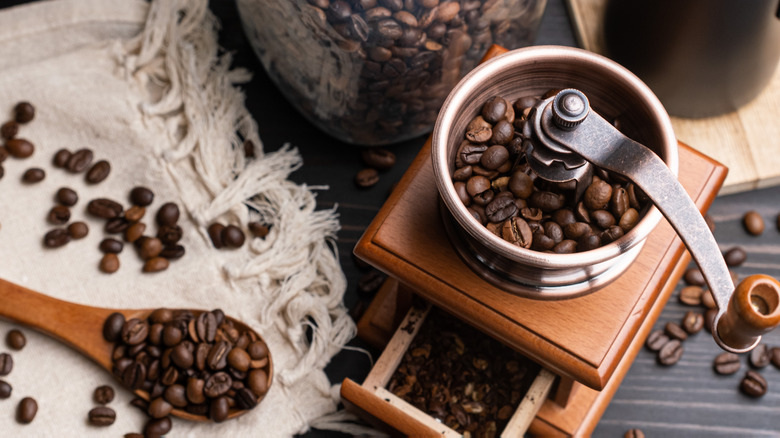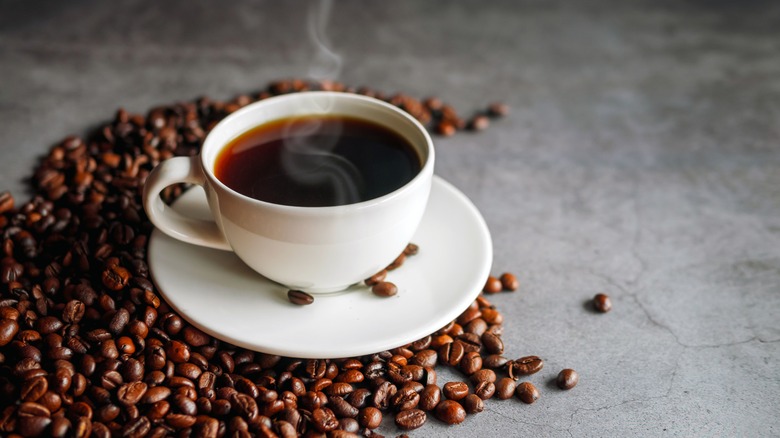Robusta Vs Arabica Coffee: What's The Difference?
We may receive a commission on purchases made from links.
The wonderful world of coffee is like a yinyang symbol: The interplay of light and dark make the coffee scene the multifaceted beauty it is. But, unlike the yinyang, coffee lovers can't have it both ways in every cup. Choosing the right coffee to suit both your taste preferences and desired brewing method is a major part of setting up your cuppa joe for success. That's why, today, we're exploring the difference between the two dominant types of coffee beans: Arabica and robusta. Nearly all types of coffee in the world come from these two types of beans.
Regardless of arabica or robusta, all coffee starts as cherries that grow on the flowering Coffea plant. Growers harvest these cherries, extract the green, raw beans within, soak the beans to remove the outer pulp, then roast them. The Coffea plant grows in different climates around the world, from Brazil to Indonesia and more, and each terroir creates an entirely different flavor and texture profile of the coffee beans that grow from the plant. This is also why single-origin beans tend to cost more than blends, for the record.
The fundamental difference between arabica and robusta beans is that they grow from different strains of the plant, which affects the respective taste and aromatic profiles of the coffee brewed from each type. Robusta coffee tastes stronger and packs more caffeine than arabica coffee, which is lighter, more acidic, and complex in flavor.
What is robusta coffee?
Robusta (aka canephora) coffee comes from the Coffea canephora plant, which isn't just "robust" in terms of flavor. The plant thrives in low altitudes (1,000-2,000 feet above sea level) and is hardier against pests and disease than arabica. It also has a high tolerance to heat, mostly growing in Uganda, Indonesia, Vietnam, and other regions in South Africa.
Due to their tendency to lean on the bitter side, robusta beans typically come with a comparatively lower price tag than arabica and are commonly used to make coffee blends. Although, as gourmands knows well, bitterness is not always a bad thing. In fact, the bold, rich, slightly bitter flavor of those robusta beans contributes a dimensional dynamic element to many pre-ground blends and instant coffees that prevents them from falling flat or being one-note.
Robusta presents a strong, earthy flavor with tasting notes of roasted nuts and dark chocolate. It performs well in dark French or Italian roasts and espresso blends. In fact, robusta is especially important to espresso fans thanks to the high concentration of carbon dioxide trapped inside the beans, which produces a foamier layer of crema when brewed. As a general rule, robusta beans are the best fit for the job when crafting espresso beverages or brewing a full pot of drip coffee. Where intensity and body matter, it's gotta be robusta.
What is arabica coffee?
Arabica is the most popular type of coffee consumed in the modern world, comprising an estimated 60-70% of all coffee globally. It comes from the Coffea arabica plant, which is prized for producing smooth-tasting beans with low bitterness. Single-origin coffees are typically made solely from arabica beans, as are specialty coffee beans crafted by smaller-batch coffee roasters, in which the desired outcome is multiple identifiable tasting notes.
Complex, subtle arabica beans are ideal for brewing craft drinks using a French press or pour over, designed for savoring sip by sip. When brewed, arabica features a floral, fruity, sweet, acidic flavor and a thinner body compared to robusta. Arabica beans predominantly grow in Ethiopia and Brazil, where they thrive at high altitudes (2,000-6,000 feet above sea level). The plants also prefer cooler temperatures and distinct rainy versus dry seasons. Its higher market demand, more specific growing conditions, and high-maintenance cultivation all contribute to arabica's higher price point compared to robusta.
Arabica and robusta offer different flavor profiles
There's a visible difference in the beans themselves. Roasted robusta beans are round and smaller than the oval-shaped, physically larger arabica beans. There are also plenty of ways to tell the difference between these two varietals based on taste alone.
Robusta beans are considered less gourmet than arabica beans for their characteristic harshness. But, which variety is "better" is largely a matter of preference. Arabica coffee tends to taste floral and smooth, while robusta coffee is smoky, nutty, and slightly bitter. Arabica coffee is also significantly more acidic than robusta, which shows up in its bright, floral flavor. On a molecular level, arabica tastes sweet and fruity due to its naturally higher levels of sugar (6-9% compared to robusta's 3-7%) and acid. Its mellow smoothness is thanks to its abundance of lipids (aka natural fats).
Arabica beans are about subtlety and complexity, while robusta beans are about earthy, strong, dark flavor. This is why arabica beans tend to show up as light roast and medium roast coffees, while medium to dark roasts are typically made from robusta beans (which has more to do with natural flavor profile than with caffeine content).
Robusta has more caffeine and a lower price tag than arabica
The phrase "not all beans are created equal" applies to both flavor and to power. Robusta beans pack roughly twice the caffeine content of arabica beans (2.2%-2.7% to arabica's 1.2%-1.5% caffeine concentration). This strength makes robusta a great fit for instant coffee granules, while arabica is commonly used to make decaf coffee. However, when robusta is incorporated into coffee blends (as it commonly is), the 200% caffeine punch is significantly lessened, so no need to fear accidentally dosing yourself with a punchy, knockout cuppa joe.
The final difference between these beans is that arabica is more expensive than robusta. While arabica is the choice for roasters and specialty coffee aficionados, it's not necessarily that arabica beans are inherently "better," as the higher price point might suggest. The robusta plant's hardiness means it's significantly easier to grow and produce en masse than arabica plants, which require specific growing conditions and more hands-on care to cultivate. Also, because arabica beans grow at such high elevations, their terrain is often mountainous or otherwise difficult to access, frequently requiring the beans be harvested by hand. Robusta beans, conversely, are easier to reach and can commonly be harvested by machine. Although, perhaps surprisingly, robusta beans only account for an estimated 30-40% of all coffee consumed worldwide.
